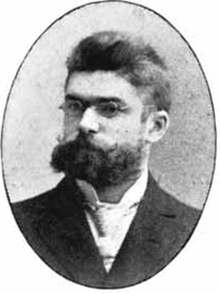Carl Wilhelm Wirtz
Carl Wilhelm Wirtz (born August 24, 1876 in Krefeld , † February 18, 1939 in Hamburg ) was a German astronomer . He is especially remembered for his statistical studies of nebulae (= spiral nebulae, galaxies ).
Life
education
After completing his studies, Wirtz accepted a position as an assistant at the Kuffner observatory in Vienna . He worked at the Strasbourg observatory from 1901 to 1911 and completed his habilitation there in 1904. In 1909 he was appointed professor. Carl Wilhelm Wirtz's son was the geologist and university professor Daniel Wirtz .
Kiel time
After being drafted into the military in 1916, Wirtz worked as a trigonometer in the General Staff in Berlin and continued his statistical astronomical investigations.
After the First World War , he moved to the Christian Albrechts University in Kiel as a lecturer and observer at the university observatory . In 1930 Wirtz left the SPD . After the seizure of power of the Nazis in 1933, he was accused of the Nazis to face critical. Although he denied this, the Reich Ministry of Education asked Rector Georg Dahm in July 1936 whether the astronomical faculty would agree to Wirtz's early retirement. As a result, his license to teach was revoked. In 1937 he was retired; a year later the observatory was also closed.
Scientific work
Wirtz also tried to advance the exploration of the cosmos with his own observations. His instrumental possibilities in Strasbourg and later in Kiel were very limited. In Strasbourg he worked on the analysis of position determinations of the nebulae in order to learn something about their position in the cosmos from their own movements in the sky. However, it only became apparent that the nebulae are distant objects - whether they are inside or outside the Milky Way remained unclear.
In Berlin, too, he continued his research on the self-motions of nebulae during the First World War . He used new radial velocities of the nebulae, especially those determined in the USA. It turned out that the nebulae had a completely different cosmic position than the stars visible in the sky.
After he was appointed to the Kiel observatory, he found two decisive relationships in 1922 and 1924, first that between brightness and radial velocity, then that between angular diameter and radial velocity of nebulae. The latter was cited by him in 1924 as proof of the correctness of a world model developed by Willem de Sitter in 1918. This De-Sitter world model can be seen as a primitive form of an expanding universe, and Wirtz is thus the first to demonstrate the expansion of the universe with the help of the radial velocities of the galaxies - albeit purely qualitatively. The convincing theoretical proof of the expansion of the universe was provided in 1927 by Abbé Georges Lemaître , who also derived the rate of expansion of the universe in his work. Edwin Hubble redefined this rate of expansion in 1929; Hubble did not believe in the reality of expansion throughout his life, even though he is constantly referred to as the 'discoverer' of the expansion of space.
In later years Wirtz mainly dealt with planets and the optical properties of the earth's atmosphere.
Honors
In his honor, an asteroid discovered by Hans-Emil Schuster in 1977 was named (26074) Carlwirtz in 2004 . A Martian crater also bears his name.
Works
- Tables and shapes from astronomy and geodesy for the hand of explorers, geographers, astronomers and geodesists . Berlin: Springer, 1918
- Star clusters, nebulae and space . Stuttgart: Franckh, 1922
literature
- HW Duerbeck: Carl Wirtz - An early observational cosmologist. Morphological Cosmology - Proceedings of the XIth Cracow Cosmological School (1988), doi : 10.1007 / 3-540-51223-3_141
- WC Seitter, HW Duerbeck: Carl Wilhelm Wirtz - Pioneer in Cosmic Dimensions. Harmonizing Cosmic Distance Scales in a Post-Hipparcos Era, ASP Conference Series, vol. 167, 237-242 ( online )
Web links
- Literature by and about Carl Wilhelm Wirtz in the catalog of the German National Library
- Publications by C. Wirtz in the Astrophysics Data System
- portrait
- Martian crater Wirtz
- Asteroid Carlwirtz
Individual evidence
- ↑ a b c d Professor Dr. Carl Wirtz. uni-kiel.de , accessed on September 10, 2013 .
- ↑ 26074 Carlwirtz (1977 TD). NASA's JPL Small-Body Database Browser ( http://ssd.jpl.nasa.gov) / , accessed September 10, 2013 .
| personal data | |
|---|---|
| SURNAME | Wirtz, Carl Wilhelm |
| BRIEF DESCRIPTION | German astronomer |
| DATE OF BIRTH | August 24, 1876 |
| PLACE OF BIRTH | Krefeld |
| DATE OF DEATH | February 18, 1939 |
| Place of death | Hamburg |
